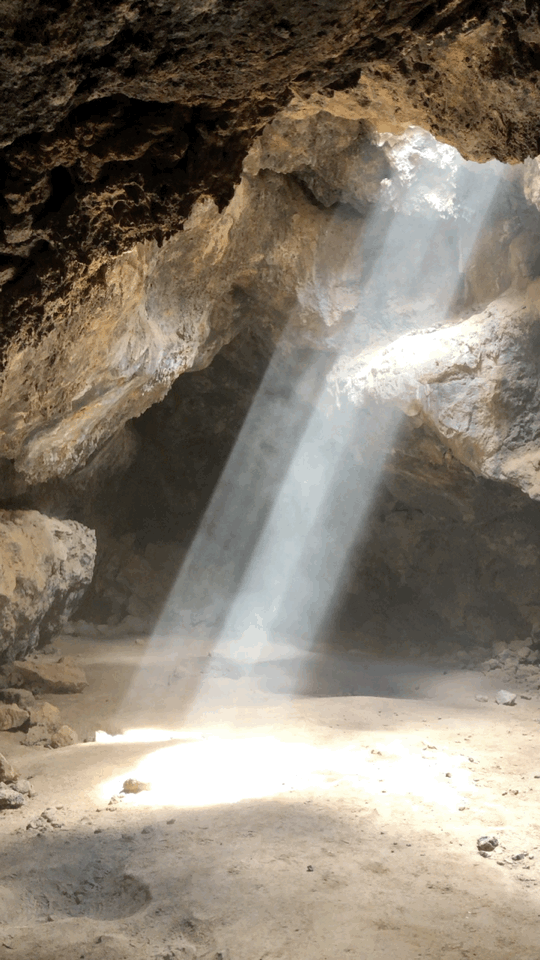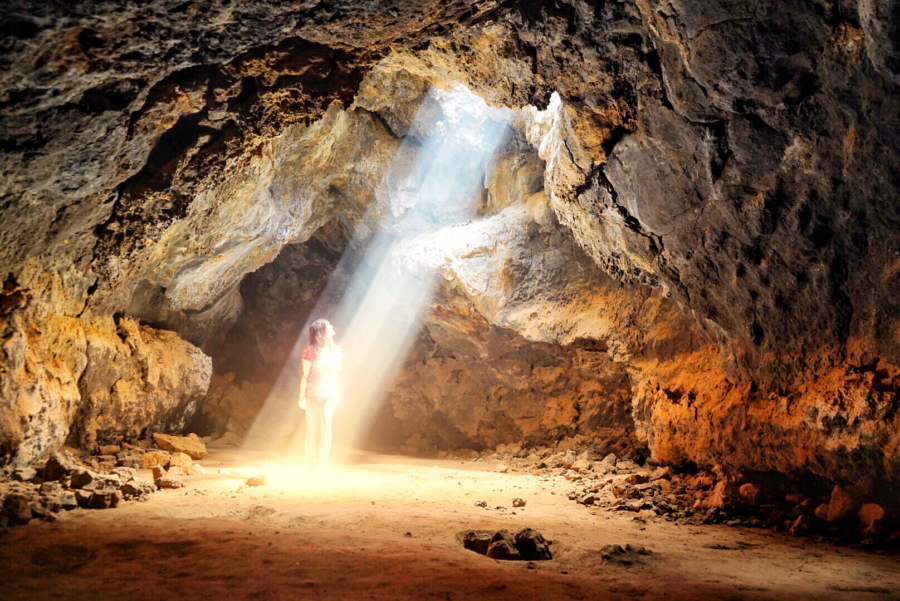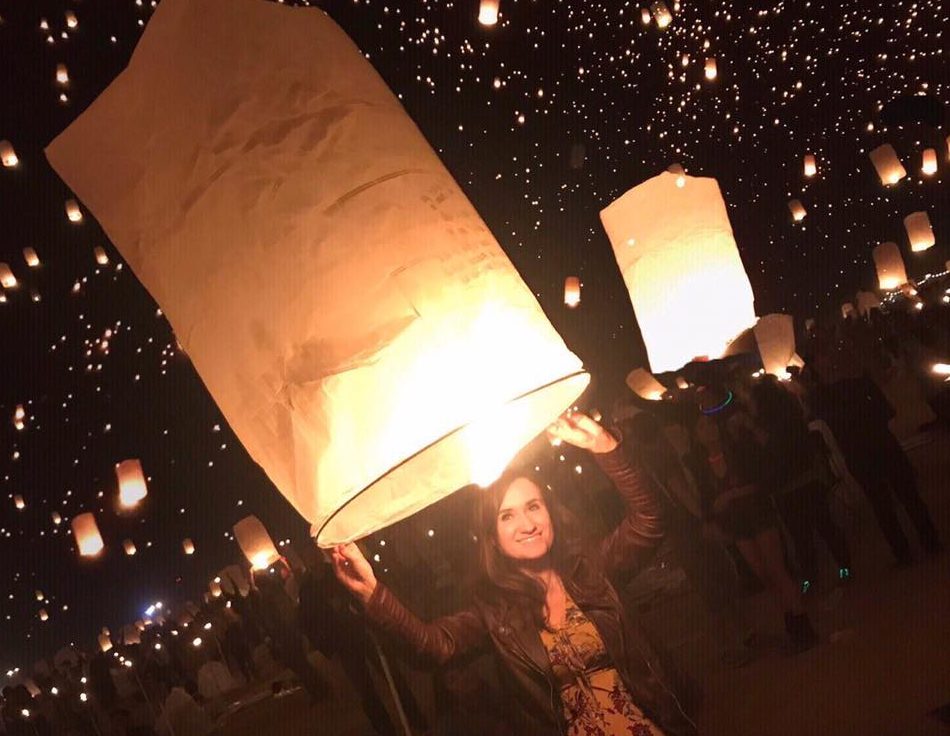If you’re driving from California to Las Vegas and only have time for one stop, make it the Lava Tube in Mojave National Preserve.
With good timing and a little luck, you’ll bask in a celestial spotlight from inside the dried-up veins of an ancient volcano. Beam me up, Scotty!

Getting There
The Lava Tube sits in the dry, dusty reaches of Mojave National Preserve, 2 hours from Las Vegas.
To get there from the Mojave National Preserve entrance (no fee or services,) you’ll need to drive 40 minutes off the Interstate and 5 miles down a dirt road until it dead ends at the Lava Tube trail. GPS coordinates here.
If the dirt road is dry, it’s accessible for most sedans and rental vehicles (though still bumpy.) If it’s recently rained in the area, though, the road will turn to mud and clay, impassable for even most 4WD vehicles.
The road, Aiken Mine Rd, can be hard to make out and there’s zero cell service, so download your map beforehand and bring a Garmin InReach in case of trouble. The closest services are in Baker, California, 40 minutes away.
Though it’s tempting to zoomzoom on the lonely desert highways, slow down for tortoises! I saw four desert tortoises crossing the road on my drive: 3 tortoises for every car I passed.

Luckily the road was bone-dry when I arrived, the sky was brilliant blue, and the desert spring wildflowers —globemallow, Engelmann’s prickly pear, and desert phacelia— were in full bloom.


The tube is about one-tenth of a mile from the road, with a lone metal post showing you the way. Follow the path/GPS coordinates until you reach a hole in the ground with a ladder in it. (It’s not far: you should still be able to see your car from the entrance.)
The steps were too steep for Juno, so I tied her to the top of the ladder and left her there with a bowl of water while I ducked into the tube. (I don’t recommend doing this in summer, but it was a balmy 60º in April.)

When I popped into the tube I found it mostly dark and occupied by the only other humans I passed in my ~3 hours in Mojave National Preserve: a French couple on a road trip.
Headlamps shining, we chatted briefly about their trip en Français until they left, disappointed at the lack of light.
But not two minutes after they parted…the clouds did, too. A celestial light switch flicked and BAM, the cave was full of light.
I shouted up “it’s here! Voilà! C’est ici!“, but the couple must have been too far to hear me.
I was worried that the photos I’d seen of the light online had been doctored, or at least taken by people with super-long exposures and fancy camera equipment.
But the light beam you see in my photos isn’t edited to appear stronger: that’s actually what it looks like!

This GIF is a totally unedited iPhone video. 😮

I was completely mesmerized.
After firing off a few iPhone photos, worried that the beam would disappear immediately, I sat on the sandy floor of the cave and just stared. It was so silent in the tube, five miles from the dirt road and at least that far from the nearest human being, that I could almost hear my own heartbeat echo off the walls.
I even had time to set up my tripod and take some shots of myself in the beam — though I now wish I’d showered that morning (yay, car camping!!) and/or worn a more camera-ready outfit. 😉
I might have stayed there all day, maybe even sat down for a gorgeously lit lunch, had a cloud not slid back in front of the sun and turned off the lightbeam like a thumb clicking off a flashlight. Without the beam I needed my headlamp again, and I scrambled back into the light and back to Juno (who was sad to leave her napping spot but happy to get back in the car.)

I didn’t see anyone else coming or going on the dirt road back, nor for many miles on the paved road out of the park. When I was in the lava tube, it seems, I’d been the only human (and Juno the only dog) for at least 20 miles. Returning to the highway full of roaring semis felt like returning from outer space.
…and maybe I did go to outer space? According to my camera timestamps, I had the lightbeam all to myself for 37 minutes.
I got chills when I saw that, despite the balmy desert air. 37 minutes?! It had truly felt like no more than five, maybe ten at the most. Maybe I’d stepped into a time warp, or been beamed up to an alien ship and back again while Juno slept at the lip of the cave?!
All I know is this: my body and mind say there’s no way I was in the cave that long. My iPhone and DSLR say otherwise.
The Best Time to Visit the Mojave Lava Tube
The best time to see the Mojave Lava Tube is as close to high noon as possible, when the sun sits directly over the opening. (My photos were taken between 12:22 and 12:59 PT.)
A few hours before or after noon should also work, though the light beam will not be quite as strong. And, as with Firefall, one rogue cloud in a beautiful blue sky can ruin your experience.
Tips for Visiting the Lava Tube
- Summer in the Mojave is blazing hot. Visit in the shoulder season if you can, though the cave itself will be cooler than the outside air.
- The “hike” to the Lava Tube is less than a quarter mile each way and not strenuous.
- When you find the opening, you’ll need to climb down a ladder and crouch down briefly to enter the tube. The one small low-ceiling section of the cave is ~3 feet tall but still pretty wide, so even the mildly claustrophic should be okay.
- If you arrive and don’t see the lightbeam, don’t leave right away! The clouds may part. I waited for 15 minutes to see the beam and am so glad I did.
- If the dirt road is dry, it’s accessible for most sedans and rental vehicles (though still bumpy.) If it’s recently rained in the area, though, the road will turn to mud and clay, impassable for even 4WD. (Google Maps directions here.)

Is the Lava Tube Dog-Friendly?
Yes! Dogs are allowed on leash at Mojave National Preserve. (Just be sure to pick up after them.) If the weather is warm, do not leave your dog in the car.

Nearby Attractions
- Kelso Dunes (50 mins)
- Zzyzx Road (45 mins)
- Mojave Road Mailbox (50 mins)
- Las Vegas (2 hours)

Where to Stay In and Near Mojave National Preserve
Juno and I continued on to Flagstaff for the night, but would love to camp in Mojave National Preserve itself on our next visit. As with most remote parks, “half the park is after dark” — I know the sunsets and desert stars would be dazzling.
Mojave National Preserve has two designated campgrounds, Mid-Hills and Hole-in-the-Wall, and plenty of roadside dispersed camping.
You can also continue on to Las Vegas (2 hours) or stay in the small town of Baker, California near the Mojave NP entrance.
Fun Facts about Mojave NP
Mojave National Preserve is huge. At 2,500 square miles, it’s bigger than over 20 countries! It’s the third-largest National Park unit in the continental U.S., after Death Valley (right next door) and Yellowstone. The Lava Tube is just one small part of this beautiful wilderness, also home to the bighorn sheep, cinder cones, and Sahara-esque giant sand dunes.
Mojave is home to more Joshua Trees than Joshua Tree National Park, plus the densest collection of Joshua Trees anywhere in the world. The first time I visited Joshua Tree National Park after spending lots of time in Mojave, I was disappointed!
(It’s also 2x bigger than J-Tree, with darker skies, fewer crowds, and the Lava Tube. If you don’t make it to Joshua Tree on your road trip but make it to Mojave, you won’t miss much.)

Have you experienced the magical Lava Tube in Mojave National Preserve? Questions about visiting? Let me know in the comments!




1 Comment
Leave your reply.